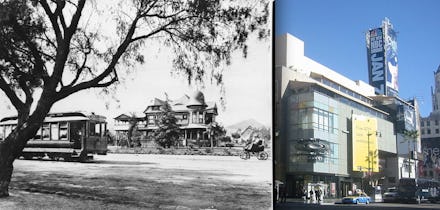Then and Now Photos Show What Hollywood Looked Like Before the Movie Business

"Hollywood is a place where they'll pay you a thousand dollars for a kiss and 50 cents for your soul."
The oft-quoted words from Marilyn Monroe give a glimpse into the culture of modern Hollywood, a mystical land of big-budget films and even bigger scandal. Driving the streets of Hollywood today it's hard to believe the city was ever anything but Tinsletown. A glance back just 100 years shows a very different landscape, a Hollywood that was a simple agricultural community still trying to lure people to live there. It's growth, of course, happened thanks to the movie business. Today as that business begins to move elsewhere, it's worth examining just how much of a visible impact the entertainment industry had on this California town.
Top: The intersection of Hollywood and Highland, 1907. Image Credit: Wikimedia Commons
Thanks to the movies, the entire world has seen the streets of Hollywood in some form or another, but Hollywood — or Hollywoodland as it was once called — didn't start out as a movie mecca. The one-tram town, designed largely by mogul H.J. Whitley in 1887, was transformed into a wealthy real estate haven, setting the stage for its future in film.
Top: The E.C Hurd ranch that Whitley purchased on what is now Hollywood Boulevard and Wilcox. Image Credit: Wordpress
In the beginning of the 20th century when film emerged as the new creative medium, the East Coast was the medium's creative hub. However, the stringent patent laws enforced by Thomas Edison's Motion Picture Patents Co. sent the burgeoning industry in search of a new, less restrictive home. The first film completed in Hollywood was The Count of Monte Cristo in 1908. As for the first movie studio, Nestor Studios moved to Hollywood in 1911. The studio set up shop on the corner of Sunset and Gower.
Image Credits: Wikimedia Commons
By 1915, Hollywood was the center of a burgeoning film industry with producers like Cecil B. DeMille and Samuel Goldwyn relocating from the East Coast. It didn't take long for both the city's infrastructure and landscape to entirely change.
In the midst of this change, a landmark emerged that would become synonymous with films, a symbol for an industry and not just a town. The Hollywood sign began as a billboard for the Hollywoodland real estate development. Its giant facade and white lights would go on to mirror the industry it would represent.
Top: WordPress
The erection of the sign seemed to spur on the evolution of the once small town. The Hollywood that started as a one-studio experiment grew into the hub of the Golden Age of cinema.
Today the movie business that built the town is seeking refuge in other locations. Because of tax incentives offered in other states and countries, production jobs in Hollywood are on the decline. Looking at the 26 biggest budget films of 2012-2013 only one was entirely filmed in California. If Hollywood looked like a sleepy community just 100 years ago, it's anyone's guess what it could look like 100 years from now especially if the industry goes in search of cheaper ground.
Wilcox Avenue from south of Prospect Avenue (later Hollywood Boulevard). Image Credit: Retronaut